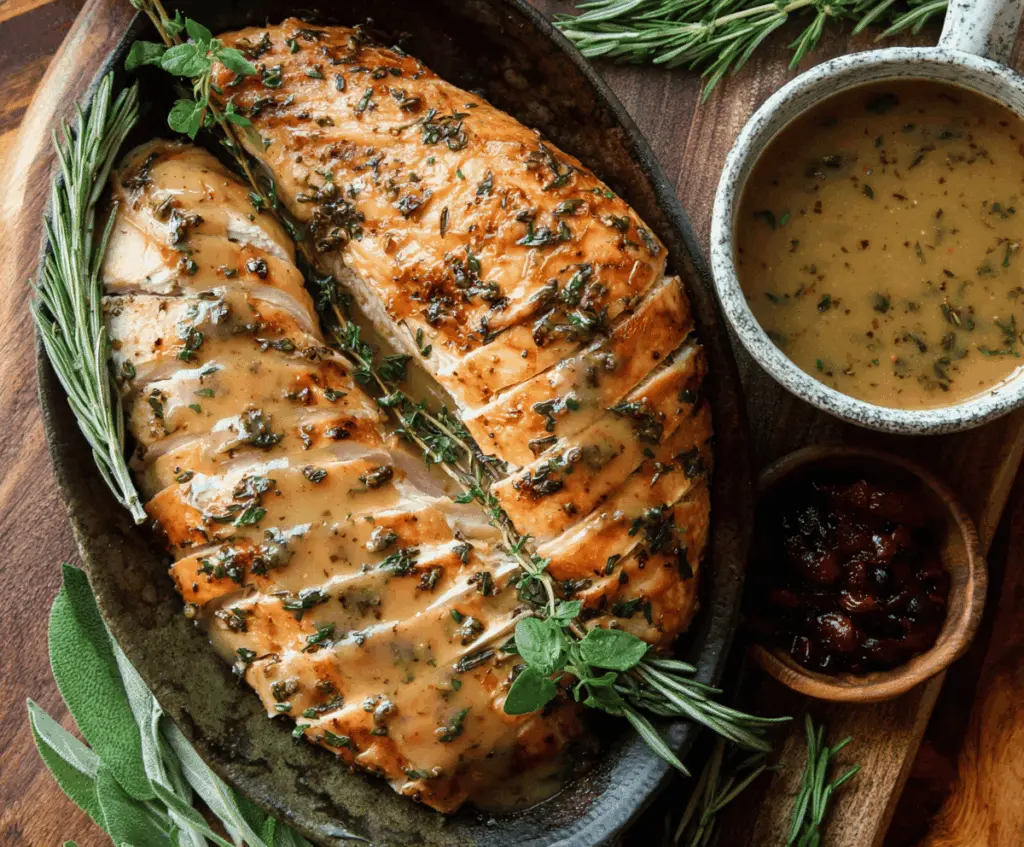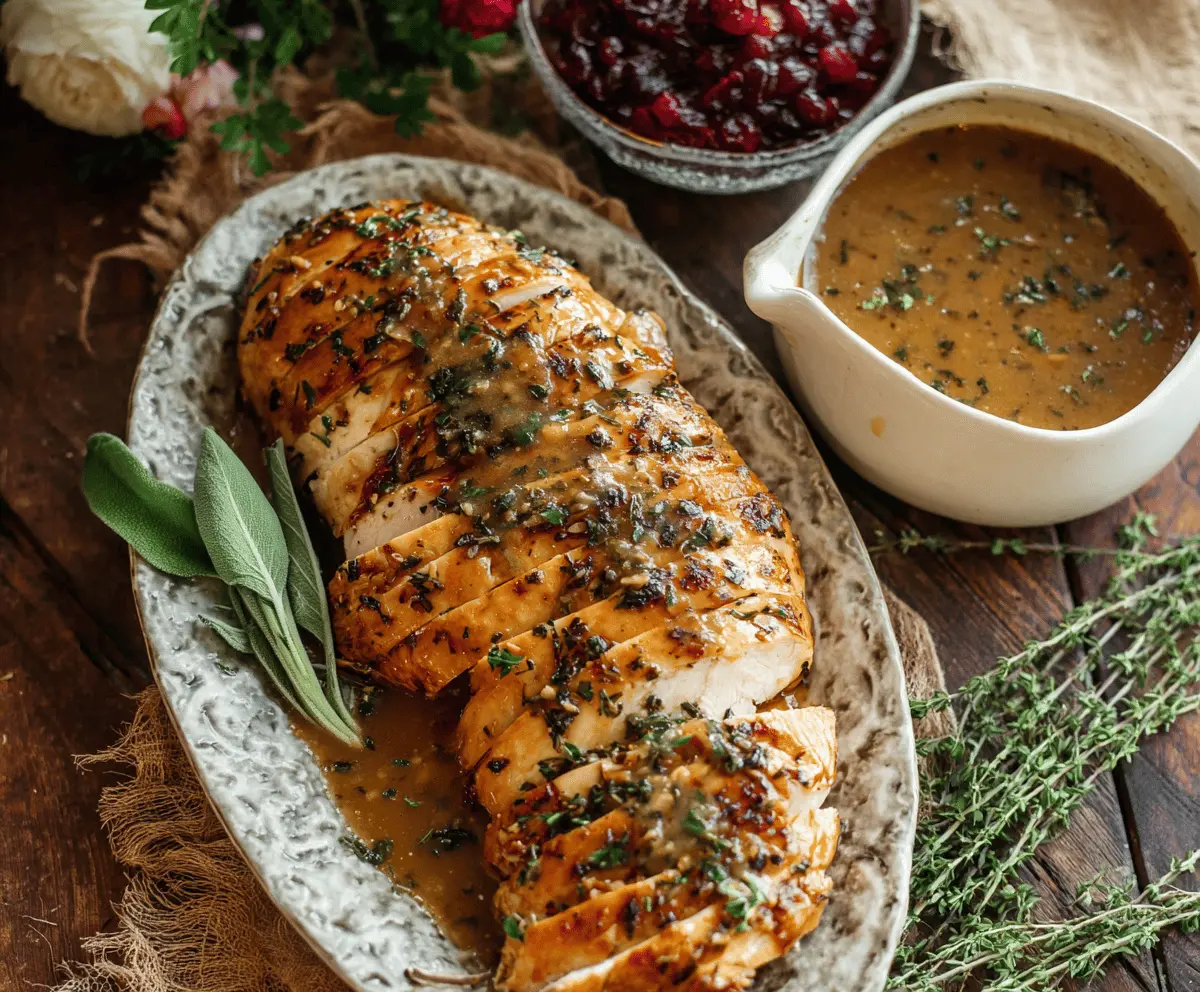
Brown Butter Herb Turkey Gravy
Brown Butter Herb Turkey Gravy is a wonderful twist on the classic gravy you love with turkey. It’s rich and nutty thanks to the brown butter and filled with fresh…
Tip: save now, cook later.Brown Butter Herb Turkey Gravy is a wonderful twist on the classic gravy you love with turkey. It’s rich and nutty thanks to the brown butter and filled with fresh herbs that add an earthy, fragrant kick. This gravy feels like a cozy hug for your turkey and mashed potatoes, bringing a little extra warmth and depth to your plate.
I really like making this gravy when I want something special but still straightforward. Browning the butter gives it that toasty flavor that changes everything, and the herbs make it taste homemade and fresh. I always find that a good spoonful of this gravy turns even simple leftovers into a meal you look forward to eating.
My favorite way to serve it is right over a slice of juicy turkey with a side of fluffy mashed potatoes or roasted veggies. It’s perfect for holidays but also great anytime you want that comforting, home-cooked feeling. Plus, it’s surprisingly easy to prepare, so you get all that amazing flavor without a lot of fuss in the kitchen.
Key Ingredients & Substitutions
Butter: Unsalted butter is best here to control the saltiness. Browning it adds a deep, nutty flavor that’s key to this gravy’s rich taste. If you want dairy-free, try a quality vegan butter that browns well.
Flour: All-purpose flour works great to thicken the gravy. For gluten-free, you can use a blend like rice or chickpea flour, but add it slowly to avoid clumps.
Turkey drippings or broth: Drippings give the most authentic flavor, but broth works fine if you don’t have drippings. Low-sodium helps balance the salt in the butter.
Fresh herbs: Thyme, rosemary, and sage bring a fresh, earthy note. Dried herbs can substitute if fresh aren’t available—use a third of the fresh amount.
Garlic: Adds an aromatic background flavor. Freshly minced is best, but garlic powder can work in a pinch.
How Do You Make Perfect Brown Butter Without Burning It?
Brown butter gives your gravy a toasty, nutty base but can quickly burn if not watched closely. Here’s what I do:
- Use a light-colored pan so you can see the butter color change clearly.
- Melt butter over medium heat, stirring or swirling frequently.
- Watch for foam forming and then listen for a nutty smell—when it turns golden brown, remove from heat immediately.
- Don’t walk away! It can go from perfect to burnt in seconds.
Getting this right makes the gravy taste rich and complex, really different from plain melted butter.
Equipment You’ll Need
- Medium saucepan – perfect size for making the gravy without crowding.
- Whisk – helps you blend the flour and liquids smoothly to avoid lumps.
- Wooden spoon or silicone spatula – great for stirring the browned butter and herbs gently.
- Heat-resistant measuring cups – for adding broth and drippings gradually and accurately.
- Fine mesh strainer (optional) – if you want a silky smooth gravy without herb bits.
Flavor Variations & Add-Ins
- Swap fresh sage for tarragon for a lighter, slightly sweet, anise-like twist.
- Stir in sautéed mushrooms for an earthy, meaty flavor that adds depth.
- Add a splash of dry white wine before whisking in broth to brighten the flavor.
- Mix in a teaspoon of Dijon mustard for a subtle tang and complexity.

Brown Butter Herb Turkey Gravy
Ingredients You’ll Need:
- 4 tbsp unsalted butter
- 2 tbsp all-purpose flour
- 1 ½ cups turkey drippings or low-sodium turkey broth
- 1 cup chicken broth (optional, to adjust thickness)
- 2 cloves garlic, minced
- 2 tsp fresh thyme, finely chopped
- 2 tsp fresh rosemary, finely chopped
- 1 tsp fresh sage, finely chopped
- Salt and freshly ground black pepper to taste
- Fresh parsley or additional herbs for garnish (optional)
How Much Time Will You Need?
This recipe takes about 15 minutes from start to finish. The key is to watch the butter closely when browning, but the actual cooking comes together quickly once you combine all the ingredients and let the gravy thicken on the stove.
Step-by-Step Instructions:
1. Brown the Butter:
In a medium saucepan over medium heat, melt the butter. Keep swirling the pan frequently as the butter foams and then turns a rich golden brown with a nutty smell—this usually takes about 4-5 minutes. Be careful not to burn it.
2. Sauté the Garlic and Herbs:
Lower the heat to medium-low, then add the minced garlic and chopped thyme, rosemary, and sage. Stir and cook for about 1 minute until you can smell the herbs and garlic releasing their fragrance.
3. Make the Roux:
Sprinkle in the flour while stirring constantly to form a smooth paste called a roux. Let this cook for about 2 minutes or until the roux is lightly golden, which gets rid of that raw flour taste and helps thicken the gravy.
4. Add the Broth and Drippings:
Slowly whisk in the turkey drippings or broth, plus the optional chicken broth if the gravy feels too thick. Keep stirring to avoid lumps, and bring the mixture to a gentle simmer.
5. Thicken and Season:
Let the gravy simmer gently for 3-5 minutes until it thickens to your liking. Taste it, then add salt and black pepper as needed. If you prefer, strain the gravy to remove the little bits of herbs for a smooth finish.
6. Serve and Enjoy:
Pour the warm gravy over sliced turkey, mashed potatoes, or your favorite side dishes. Garnish with some fresh parsley or herbs if you like a bit of color and extra flavor.
Can I Use Frozen Turkey Drippings or Broth?
Yes! If using frozen drippings or broth, be sure to thaw them fully in the refrigerator overnight or quickly in a sealed bag in cold water. This helps the gravy blend smoothly without clumps.
Can I Make This Gravy Ahead of Time?
Absolutely. Prepare the gravy up to 2 days in advance and store it in an airtight container in the fridge. Reheat gently on the stove over low heat, whisking occasionally. Add a splash of broth if it thickens too much.
How Do I Fix Lumpy Gravy?
If lumps form, try vigorously whisking while warming the gravy. You can also strain it through a fine mesh sieve for a silky texture. Adding the broth gradually while whisking helps prevent lumps from forming.
Can I Substitute Dried Herbs for Fresh?
Yes! Use about one-third the amount of dried herbs compared to fresh, since dried herbs are more concentrated. Add them earlier in the cooking process to allow their flavors to release.
